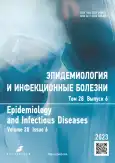A case of tonsillitis caused by parasitization of Clinostomum complanatum
- Authors: Kozlov S.S.1,2,3, Ermakova L.A.4, Turitsin V.S.2,5, Zotova M.A.6
-
Affiliations:
- Pediatric Research and Clinical Center for Infectious Diseases
- Kirov Military Medical Academy
- Saint Petersburg State Pediatric Medical University
- Rostov Research Institute of Microbiology and Parasitology
- Saint Petersburg State Agrarian University
- Center of Hygiene and Epidemiology in the Tambov Region
- Issue: Vol 28, No 6 (2023)
- Pages: 401-406
- Section: CASE REPORTS
- URL: https://journals.rcsi.science/1560-9529/article/view/251348
- DOI: https://doi.org/10.17816/EID608179
- ID: 251348
Cite item
Abstract
Trematode Clinostomum complanatum Rudolphi 1814 is a common helminth of fish-eating birds and is widespread worldwide. Larvae of this parasite live in freshwater fish. Clinostomiasis cases are rare but can occur in people who eat thermally untreated freshwater fish. We describe a case of clinostomosis in a resident of the Tambov region in Russia. The first signs of the disease developed on day 3 after eating river fish (perch). In the next 2 days, the symptoms intensified. After examination of the oropharynx, five species of C. complanatum were removed, and the patient recovered.
Full Text
##article.viewOnOriginalSite##About the authors
Sergei S. Kozlov
Pediatric Research and Clinical Center for Infectious Diseases; Kirov Military Medical Academy; Saint Petersburg State Pediatric Medical University
Author for correspondence.
Email: infectology@mail.ru
ORCID iD: 0000-0003-0632-7306
SPIN-code: 5519-6057
MD, Dr. Sci (Med.), Professor
Russian Federation, Saint Petersburg; Saint Petersburg; Saint PetersburgLarisa A. Ermakova
Rostov Research Institute of Microbiology and Parasitology
Email: ya.parazitov-net@yandex.ru
ORCID iD: 0000-0002-8918-2271
SPIN-code: 5116-9179
MD, Cand. Sci. (Med.)
Russian Federation, Rostov-on-DonVladimir S. Turitsin
Kirov Military Medical Academy; Saint Petersburg State Agrarian University
Email: turicin_spb@mail.ru
ORCID iD: 0000-0001-9066-0026
SPIN-code: 2022-1869
MD, Cand. Sci. (Biol)
Russian Federation, Saint Petersburg; Saint PetersburgMarina A. Zotova
Center of Hygiene and Epidemiology in the Tambov Region
Email: infection@list.ru
Russian Federation, Tambov
References
- Matthews D, Cribb T. Digenetic trematodes of the genus Clinostomum Leidy, 1856 (Digenea: Clinostomidae) from birds of Queensland, Australia, including C. wilsoni n. sp. from Egretta intermedia. Syst Parasitol. 1998;39(3):199–208. doi: 10.1023/A:1005982530560
- Sohn WM. Fish-borne zoonotic trematode metacercariae in the Republic of Korea. Korean J Parasitol. 2009;47 suppl.:103–113.
- Khojayan AB, Kozlov SS, Golubeva MV, editors. Medical parasitology and parasitic diseases. Protozooses and helminthioses. Moscow: GEOTAR-Media; 2016. (In Russ.).
- Kim H, Cho SW, Oh H, Byeon HK. A Case of Unexpected Clinostomum complanatum Infection Initially Presenting as Foreign Body in Pharynx. Korean J Parasitol. 2019;57(2):175–177. doi: 10.3347/kjp.2019.57.2.175
- Bronshtejn AM, Kozlov SS, Malyshev NA, et al. Acute infection of Opisthorchis felineus in Moscow: casesfrom delivered fish and cases in tourists travelled to endemic regions in Russia. Journal Infectology. 2019;11(1):76–83. doi: 10.22625/2072-6732-2019-11-1-76-83
Supplementary files









